The billion-pound London rail project called "Crossrail" when it began opened a year ago as the Elizabeth Line. I rode it for the first time to West Ealing last Sunday, and thought it absolutely the slickest, cleanest train in the UK. (I'll ride it again tomorrow thanks to industrial action and construction on the Piccadilly Line.)
British Airways pilot Mark Vanhoenacker takes it every time he comes home from a trip, and loves how it connects the city in all new ways:
Running from Reading and Heathrow Airport in the west to Shenfield and Abbey Wood in the east, the Elizabeth line brings an additional 1.5 million people within 45 minutes of the capital’s busiest districts; eases congestion on older lines; and makes London more accessible to all, as wheelchair users can reach its platforms from street level. As a pilot who commutes to Heathrow — I fly the Boeing 787 for British Airways — I’m often among its 600,000 weekday riders. The line, which runs alongside the Heathrow Express, offers another comfortable way to get to work.
[T]he line empowers travelers to leave behind the familiarities of Zone 1 — the often tourist-clogged core of the city’s transport network — and embark on fast, inexpensive journeys to fascinating outer-London destinations.
On the line’s northeastern branch lies the market town of Romford. Start at the Havering Museum, whose exhibits include a model of the long-gone Havering Palace, where Queen Elizabeth I occasionally stayed. You’ll also learn about Romford’s link to William Kempe, an actor in several of Shakespeare’s original productions, who morris danced around 100 miles from London to Norwich in 1600, and about the weights and measures that once set standards in Romford’s market.
It’s fitting, then, that the first station beyond [the eastern Thames] tunnels is Woolwich, where armaments were manufactured for around three centuries, including by one Henry Shrapnel. Woolwich was also renowned for music — its Royal Artillery Band, Britain’s first formal military band, was organized in 1762 — and for football: Arsenal, based today in Islington and still nicknamed “the Gunners,” was founded here in 1886 as a team for armaments workers.
Between my arrival this afternoon and my departure tomorrow afternoon I'll be in the UK only 23 hours, many of them in my hotel room asleep, so I won't have time to explore the places Vanhoenacker describes. But I have a hunch I'll return to the London before too long.
I took a quick trip to Berchtesgaden, Germany, this afternoon. I think it might be the most beautiful place I've seen in Europe:
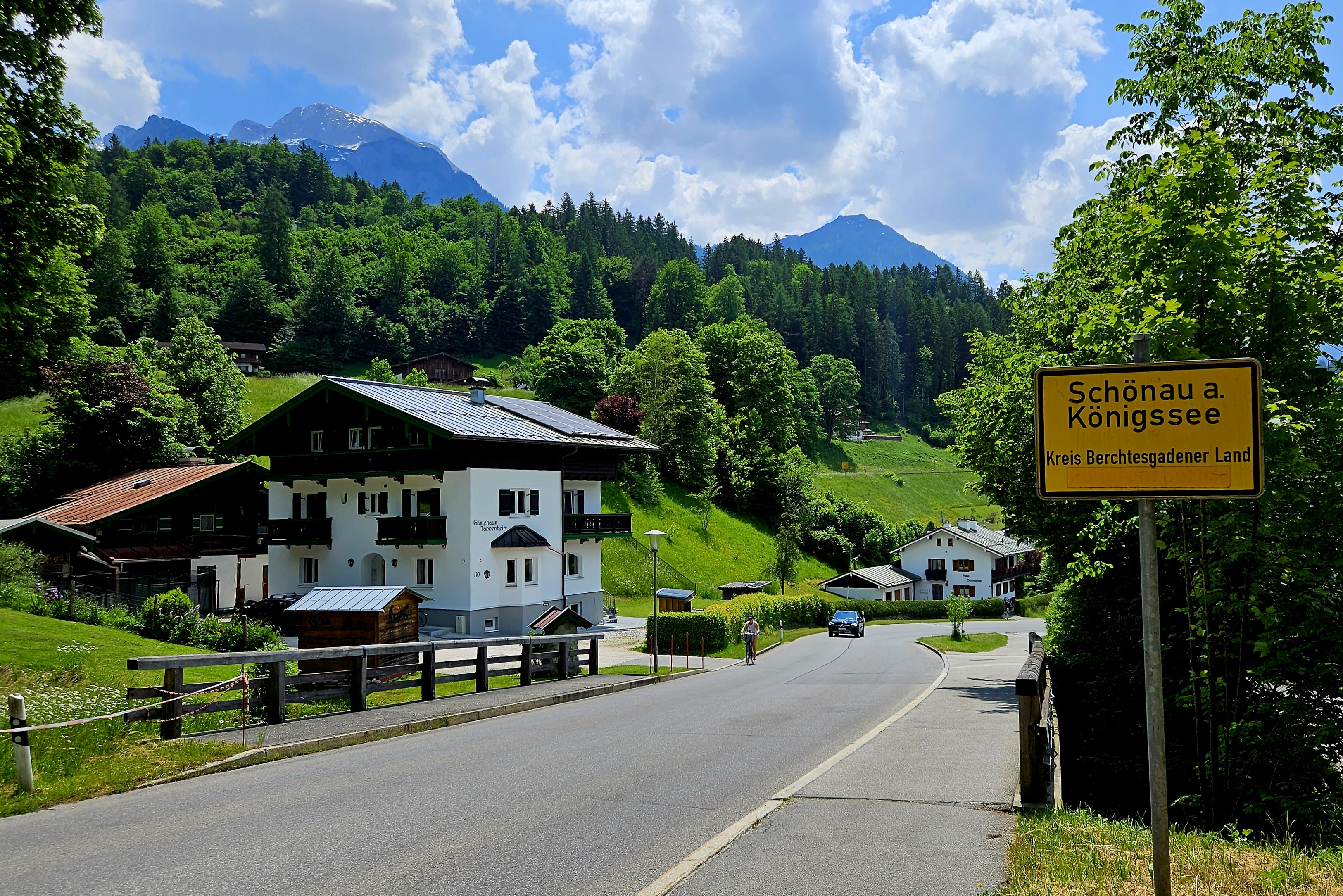
I didn't stay too long, but I did get in a 2½ km walk that included part of a river path:

The whole area looks like Bavarian storybook hour:
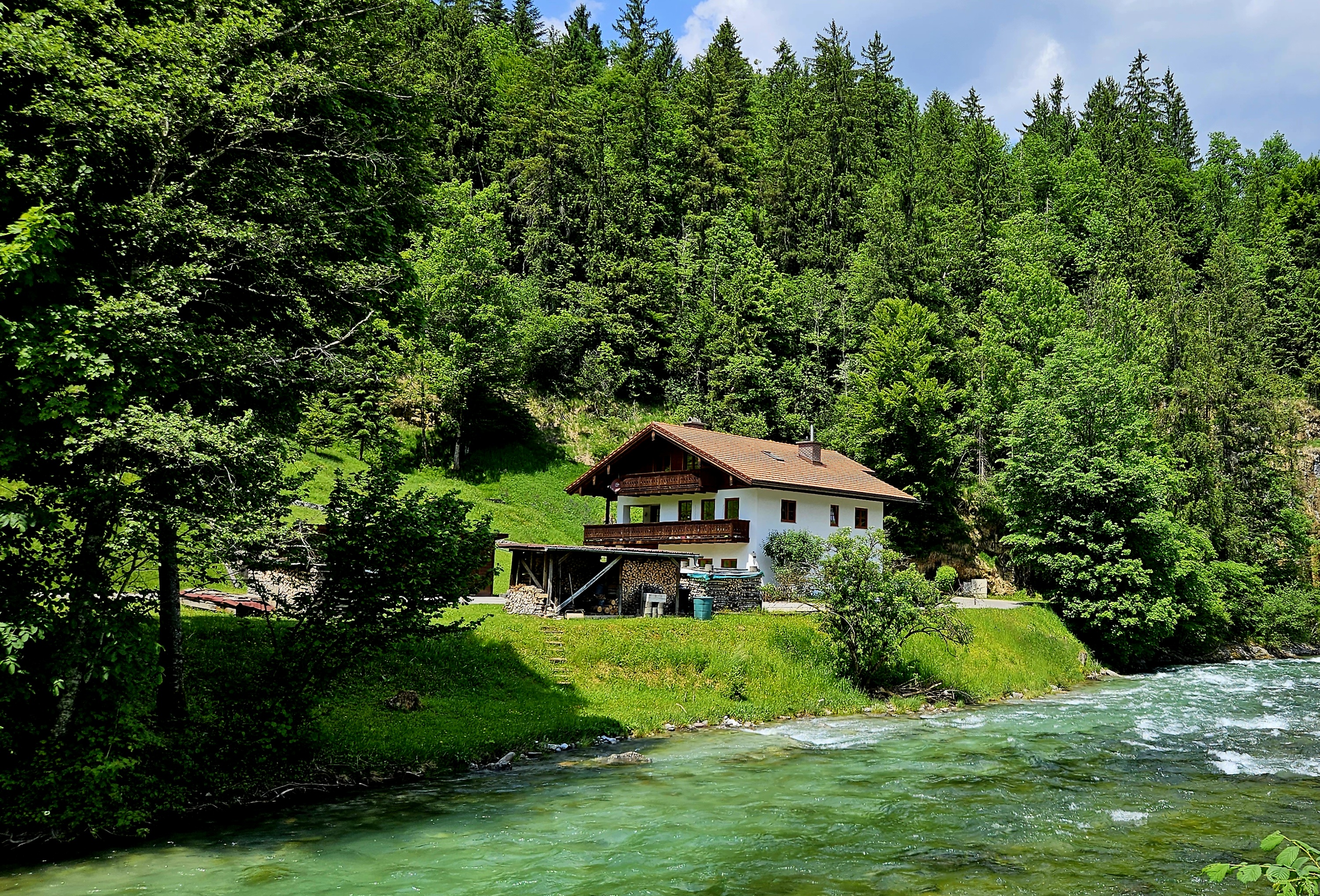
To get there, you take a train from Freilassing, a nondescript town just over the German border from Salzburg. The train meanders through Alpine meadows at a slow but steady pace, passing through this kind of scenery:
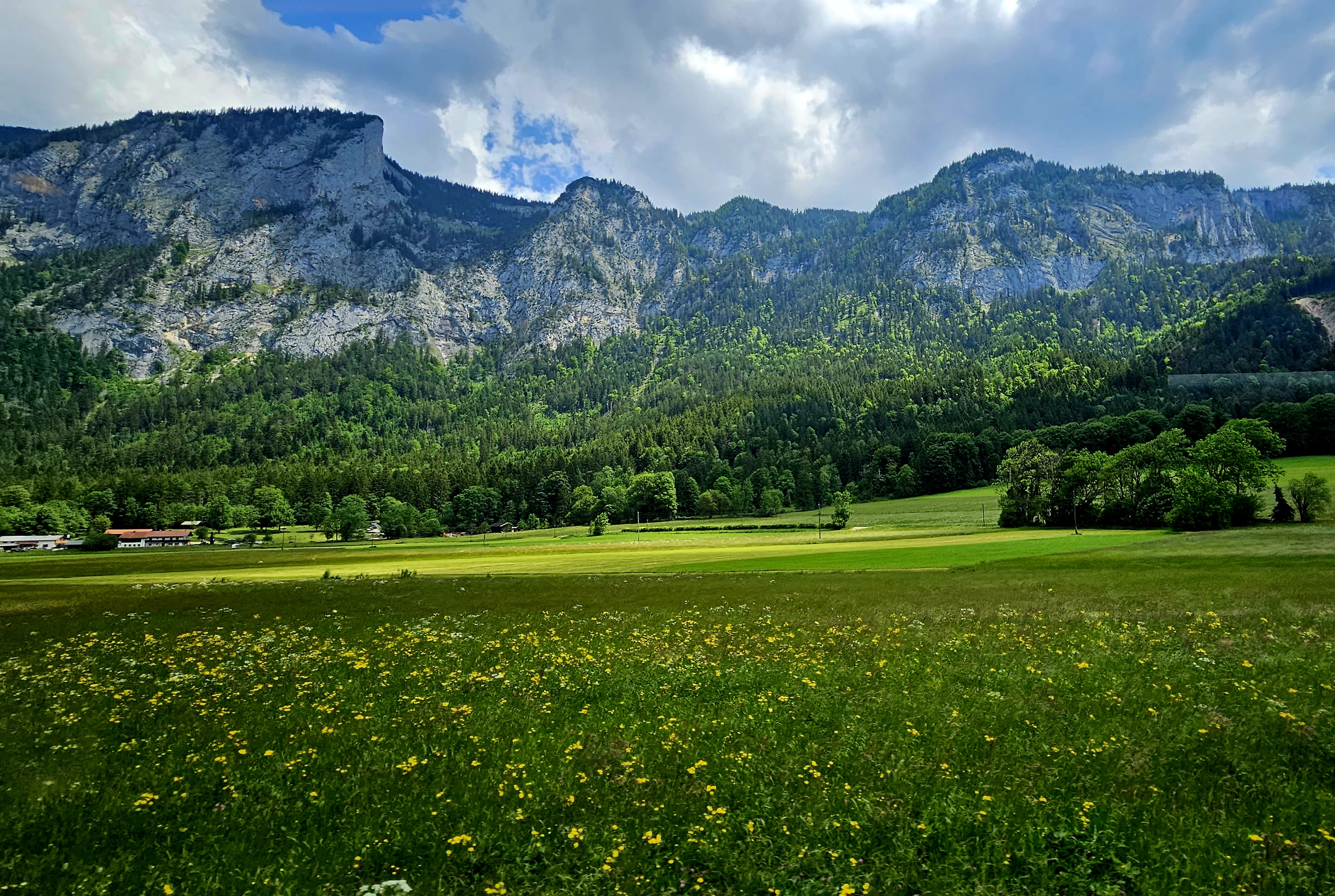
I will pass through again and make sure to stay longer.
I did have a bit of an uncomfortable moment at the border. The German police held the train from Salzburg for a few minutes before letting us off, as four armed officers walked through from end to end. It was at about that moment that I remembered I left my passport in my room safe back in Austria. Turns out, they didn't check passports (both countries are in the Schengen area), but still. I do carry my passport card with me at all times overseas, but that's only proof of citizenship at US land and sea borders—and, crucially, at US consulates and embassies. But I don't believe the Bundespolizei would recognize it as such.
Not that I needed to worry. I just have to be more careful about that. (I did bring my passport book to Bratislava, for instance.)
I have discovered the tram network, so I took it to the Royal Gardens and the Castle. (Also, apparently, to the president's residence, but the Czech army dissuaded me from exploring that area.) I wish we had something like this in Chicago, but then again, we don't have anything like this in Chicago either:
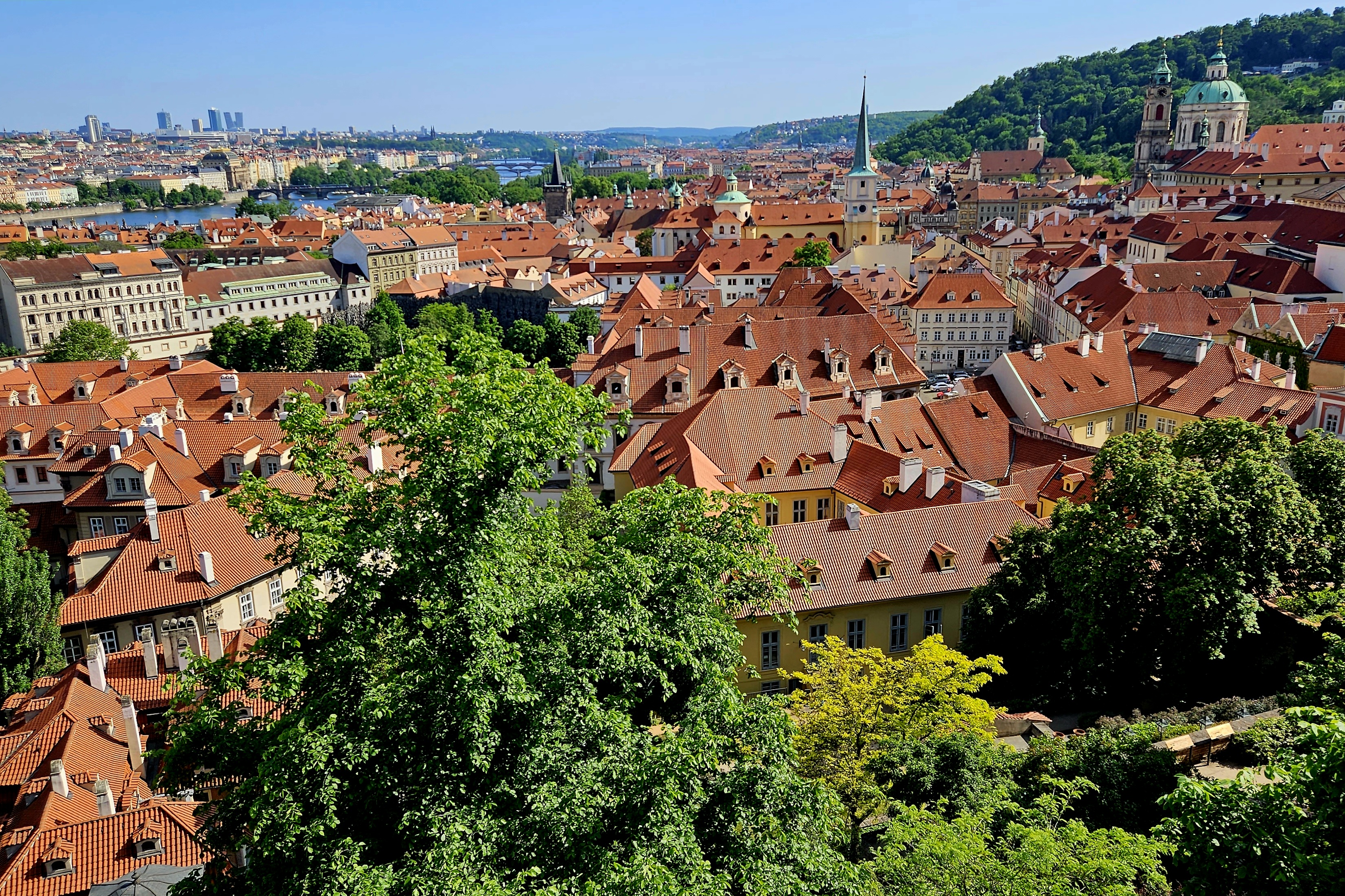
I took a short (5.5 km) walk and ended with a Czech open-faced egg sandwich:
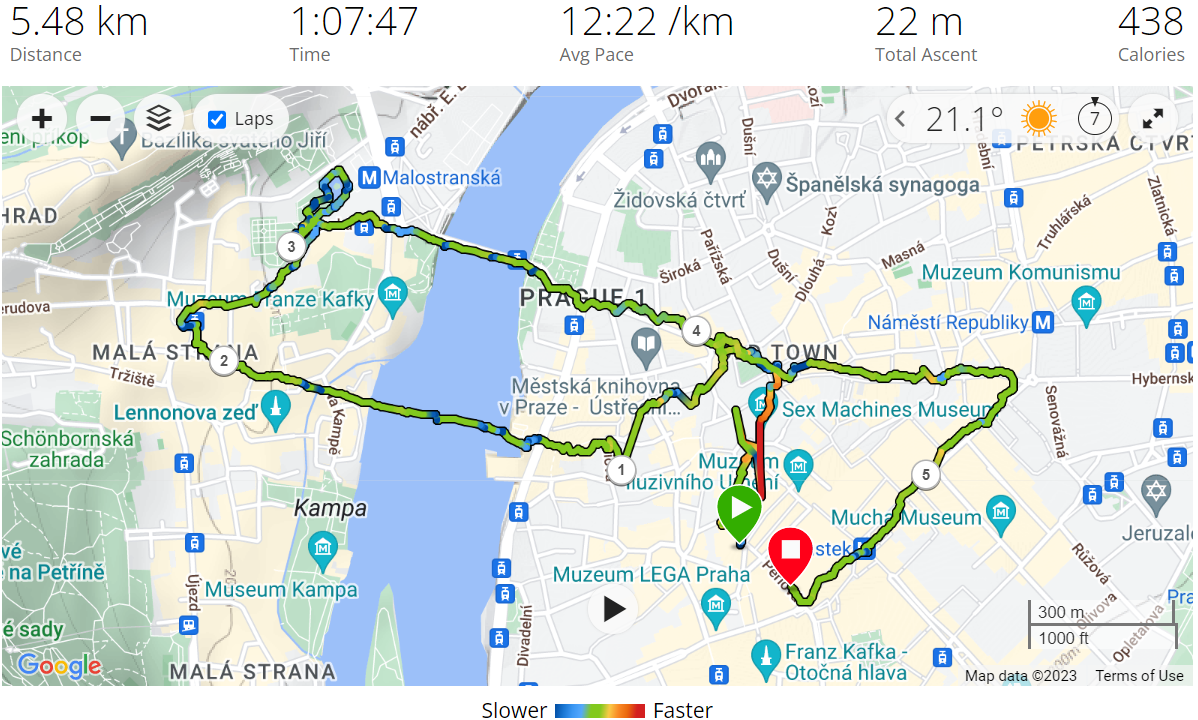
For the record, I didn't stop in the Sex Machines Museum, tempting as that sounded. Stopping ever few meters to take photos didn't help my time. Neither did the perfect weather.
I did stroll around the Czech Senate grounds, which felt a lot different than our Capitol Hill:

It almost felt as if our Senate sits in a building designed to dominate the city around it, while Czechia's sits in a walled garden. There's some profound political theory in there, I'm sure.
Boarding pass from Chicago to Heathrow in app? Check.
Boarding pass from Heathrow to Prague in app? Check.
Packed? Uh...sure, once this laundry is done...
Linguist Anvita Abbi studied the language family on Great Andaman (just south of Myanmar in the Andaman Sea) and made a fascinating discovery:
Somehow my extensive experience with all five Indian language families was no help. One time I asked Nao Jr. to tell me the word for “blood.” He looked at me as if I were an utter fool and did not reply. When I insisted, he said, “Tell me where it is coming from.” I replied, “From nowhere.” Irritated, he repeated, “Where did you see it?” Now I had to make up something, so I said, “On the finger.” The reply came promptly—“ongtei!”—and then he rattled off several words for blood on different parts of the body. If the blood emerged from the feet or legs, it was otei; internal bleeding was etei; and a clot on the skin was ertei. Something as basic as a noun changed form depending on location.
The grammar I was piecing together was based primarily on Jero, but a look through Portman's and Man's books convinced me that the southern Great Andamanese languages had similar structures. The lexicon consisted of two classes of words: free and bound. The free words were all nouns that referred to the environment and its denizens, such as ra for “pig.” They could occur alone. The bound words were nouns, verbs, adjectives and adverbs that always existed with markers indicating a relation to other objects, events or states. The markers (specifically, a-; er-; ong-; ot-or ut-; e-or i-; ara-; and o-) derived from seven zones of the body and were attached to a root word, usually as a prefix, to describe concepts such as “inside,” “outside,” “upper” and “lower.” For example, the morpheme er-, which qualified most anything having to do with an outer body part, could be stuck to -cho to yield ercho, meaning “head.” A pig's head was thus raercho.
[My] studies established that the 10 original Great Andamanese languages belonged to a single family. Moreover, that family was unique in having a grammatical system based on the human body at every structural level. A handful of other Indigenous languages, such as Papantla Totonac, spoken in Mexico, and Matsés, spoken in Peru and Brazil, also used terms referring to body parts to form words. But these terms had not morphed into abstract symbols, nor did they spread to every other part of speech.
I envy Abbi's ability to do that. I've spent 8 weeks now trying to sort out Czech grammar and have only just started to understand the accusative case. It makes a guy want to stick with German...
As the wildfires in western Canada continue to burn, we in Chicago continue to live under the smoke plume, going on four days now. NASA's Earth Observatory has art:

Raging fires filled the skies of southern Canada and the northern United States with smoke in mid-May 2023. The fires had scorched 478,000 hectares (1,800 square miles) in Alberta, British Columbia, and Saskatchewan, as of May 16, which is 10-times the average area burned for this time of year.
As of May 16, there were 87 wildland fires burning in Alberta, a quarter of which were classified as out of control, meaning the fires were expected to grow in size. A majority of the 478,000 hectares burned have been in Alberta, according to the Canadian Wildland Fire Information System, but several fires were classified as burning out of control on that day in British Columbia and Saskatchewan.
Wind brought smoke from the fires down to Maryland on May 10, making the Sun look milky in the sky. The AERONET instrument at NASA Goddard in Greenbelt, Maryland, had an average AOD value of about 1 in visible wavelengths on that day. On May 16, smoke contributed to hazy skies and hazardous air quality in North Dakota and northern Minnesota. An AERONET sensor at the University of North Dakota in Grand Forks measured an average AOD of 2.3 on May 16, with peak values close to 3.
Unseasonably hot weather is expected to continue over the next few days in Western Canada. In British Columbia, temperatures are expected to reach 30° Celsius (86° Fahrenheit) through May 18, according to Environment Canada.
New York Times columnist David Wallace-Wells forecasts a hazy future:
[A] new lesson from the evolving science of wildfire is about how far its toxic smoke spreads and how widely its noxious impacts are distributed. You may think of fire in terms of scorched homes and go bags sitting ready for sudden evacuation. But distance is no cordon sanitaire for smoke. In fact, according to one not-yet-published study led by Stanford researchers exploring the distribution of wildfire smoke, an estimated 60 percent of the smoke impact of American wildfire is experienced by those living outside the states where the trees are in flames. Eighty-seven percent of the impact is experienced by those living outside the county of the original fire. And the problem is getting much worse.
[W]hile Americans often think of wildfires as a California problem, it’s much bigger than that, with more burning elsewhere in the country every year. By some estimates, land burned across the American West grew ninefold between 1984 and 2015. It may increase several more times over in the decades ahead. The number of people exposed to what are sometimes called extreme exposure days — when particulate matter is about seven times as high as the World Health Organization safety standard — has grown 27-fold in just the last decade.
In recent years, wildfire smoke accounted for up to half of all air pollution in the American West — meaning that if you live there, as much particulate matter has blown into your skies and your lungs from the burning of trees and brush as from all other human and industrial activity combined. And the grim effects are not locally constrained: Approximately half of American deaths from all forms of air pollution come from out-of-state sources, according to one study published in Nature in 2020 — a finding that implies a remarkably large toll, given that estimates for the total number of premature American deaths attributable to fossil fuel pollution in a given year run as high as 350,000.
Today's layer of smoky haze is pretty high up over Chicago, so my ground-based AQI is a healthy 23. But you might want to reconsider your getaway weekend in Calgary.
We seem to get a lot of pneumonia fronts lately. Here's yesterday's:
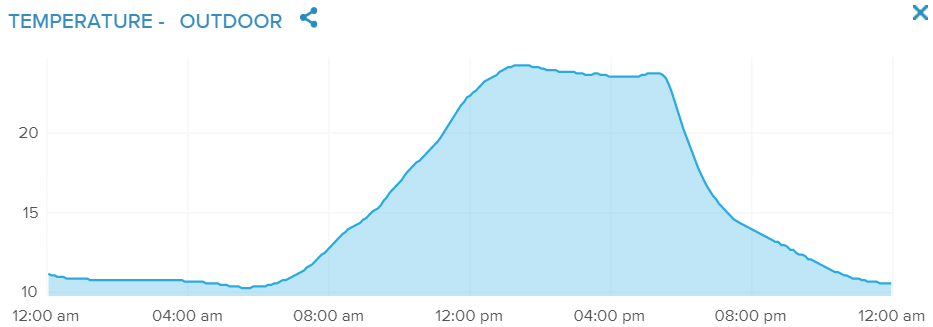
The temperature at IDTWHQ was 23.5°C at 17:35, 22.6°C at 17:45, 20.9°C at 18:00, and down it went, to 15.9°C by 19:00. (For the Philistines, that's a 14°F drop in 90 minutes.) At about that time, smoke from fires in Alberta combined with rapid condensation aloft (i.e., clouds from the cold front) to give us one hell of a filter for the sun:
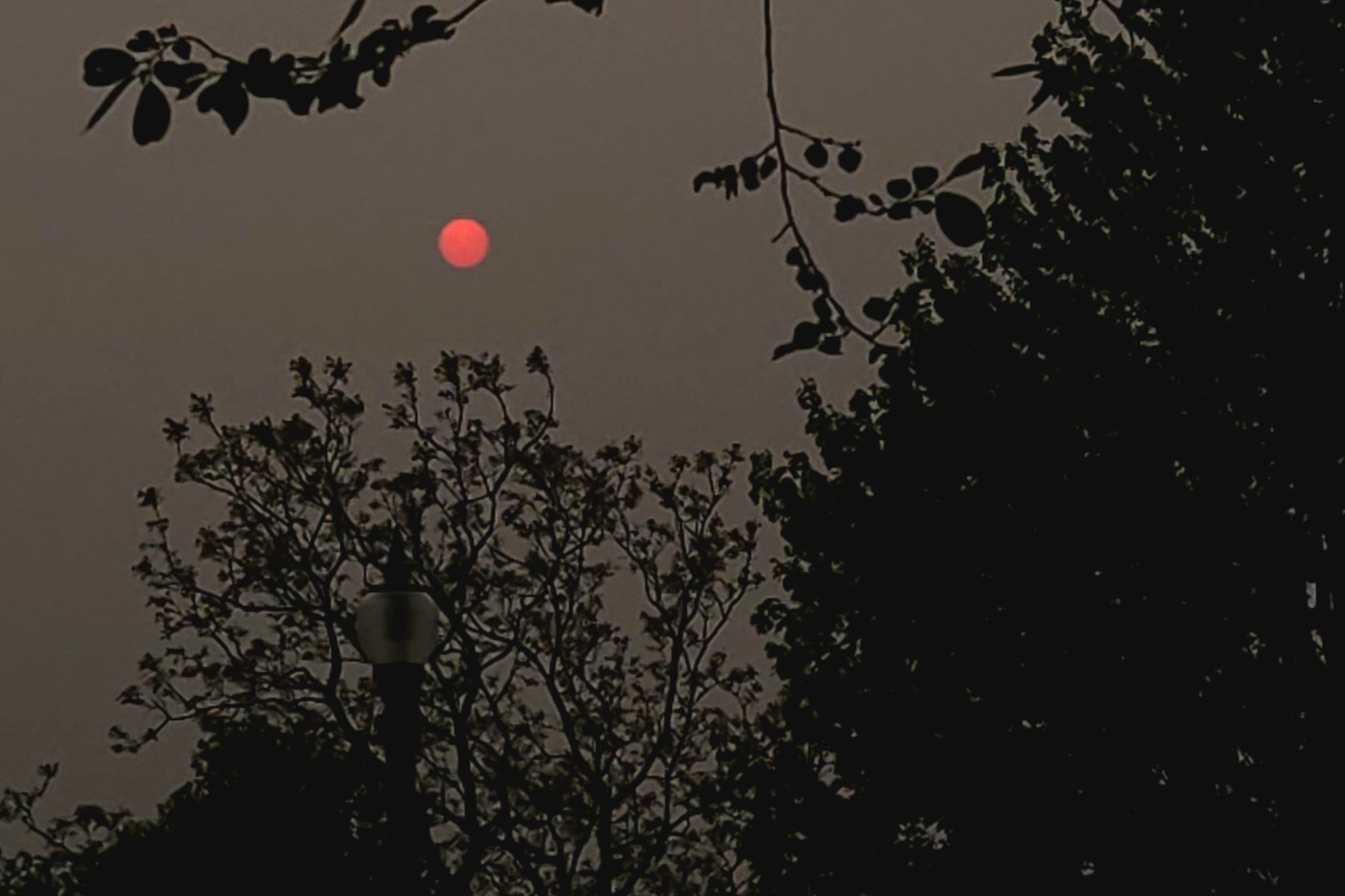
I used a daylight color temperature (5700K) for that shot so you can see the color I saw.
Here's the NOAA Global Systems Laboratory map from that moment:
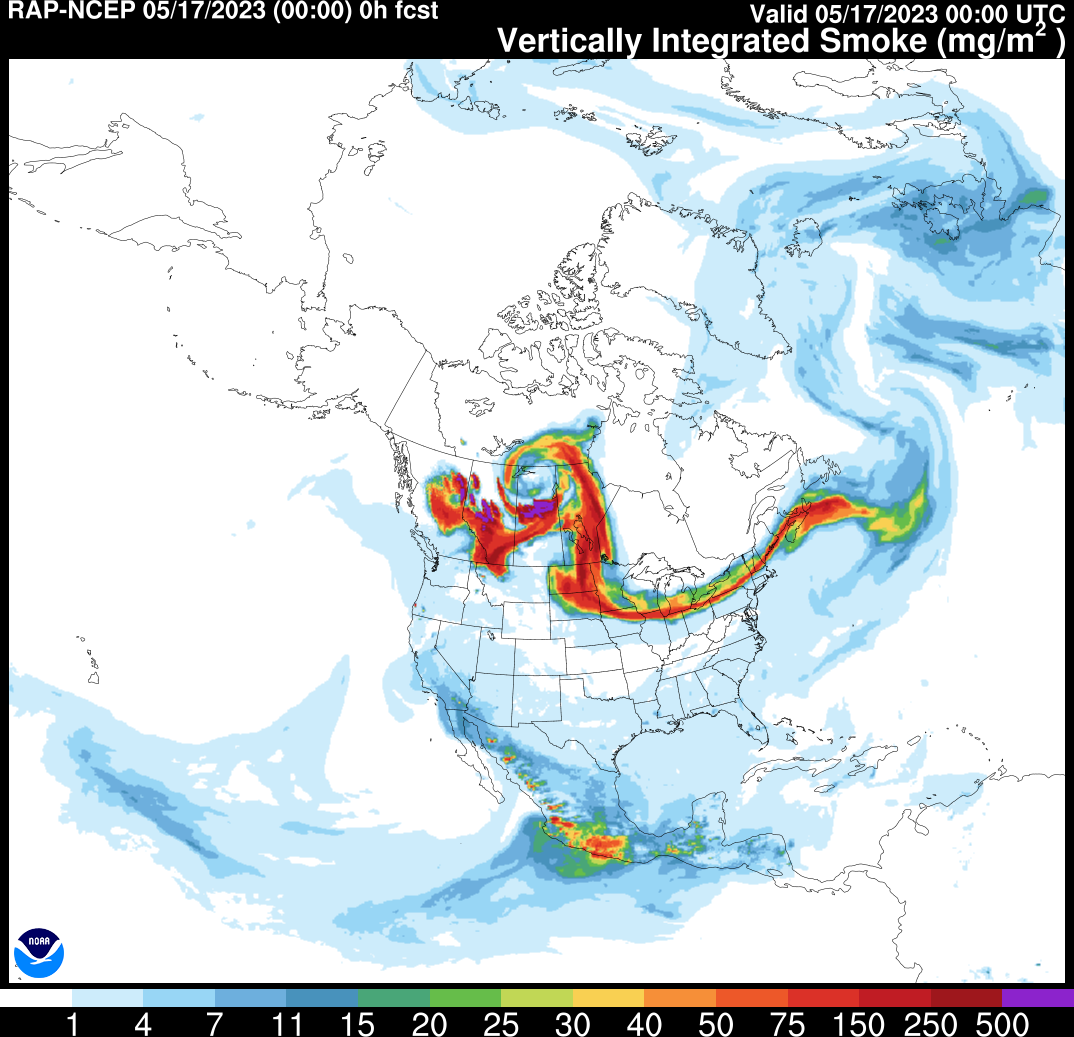
Strangely, the air-quality index at WHQ—right now, a super-healthy 15—suggests not a lot of the smoke is getting to the surface. It still seems a bit hazy though. And we're likely to have another beautiful sunset tonight.
During the weeks around our Spring Concert, like during the first couple of weeks of December, I have almost no free time. The Beethoven performance also took away an entire day. Yesterday I had hoped to finish a bit of code linking my home weather station to Weather Now, but alas, I studied German instead.
Plus, with the aforementioned Spring Concerts on Friday and today, I felt that Cassie needed some couch time. (We both sit on the couch while I read or watch TV and she gets non-stop pats. It's good for both of us.) She'll get more couch time tonight, don't worry. But she'll also be home alone for about 7 hours today.
I don't have rehearsal tomorrow, and in fact I have no responsibilities beyond my normal day job until next Saturday, so I should finish the coding soon. (I also have a task for an old client that will take me a dozen or so hours, and I really need to start that before my trip.)
In the hour I have before Cassie's next walk and me driving out to Oak Park, I need to study more German and some Czech. In the former we're now discussing how the bear and the mouse need to an apartment („Der Bär und die Maus brauchen eine Wohnung”, for what purpose I can only imagine), and in the latter, whether I eat salt („Jíš sůl?”) and that they have good coffee („Kávu mají dobrou”). Clearly I have more work to do in Czech.
The Daily Parker began as a joke-of-the-day engine at the newly-established braverman.org on 13 May 1998. This will be my 8,907th post since 1998 and my 8,710th since 13 November 2005. And according to a quick SQL Server query I just ran, The Daily Parker contains 15,043,497 bytes of text and HTML.
A large portion of posts just curate the news and opinions that I've read during the day. But sometimes I actually employ thought and creativity, as in these favorites from the past 25 years:
- Old Man Moskowitz, sent in by an old friend in New York, 26 May 1998.
- My all-time-favorite Jewish joke, 23 June 1998. (And my second-favorite, 31 January 2003.)
- My all-time-favorite engineering joke, 11 February 2000.
- An essay on conspiracies and coincidence, 22 January 2006.
- Rant about Microsoft certification exams, 29 June 2006.
- Feeling sad about the end of Kodachrome, 31 December 2010.
- My friends and I debate the merits (such as they were) of Wisconsin Governor Scott Walker (R), 26 March 2011.
- An examination of the Astrolabe lawsuit against the Time Zone Database, 22 October 2011, and Astrolabe's response on 14 October 2011.
- A rant about Tea Party Republicans, 14 August 2012.
- Three articles in the New York Times inspire two lengthy explanations and a rant, 18 December 2012.
- The Y2K problem and other date disasters in programming, 29 April 2018.
- The Music Theory A-Z challenge, starting on 1 April 2019.
- The entire series on logical fallacies, July-August 2019.
- My obituary for Parker, 18 November 2020.
- Star Trek: Discovery's 3rd season irked me, 3 December 2020.
- Neon CRM also irked me, 10 February 2021. (Hmm...I wrote longer blog posts in the months when I didn't have a dog.)
- Cassie comes home from PAWS, 16 March 2021.
- My struggles to play SimCity 4, 25 years after I bought it, 8 May 2021.
- Lots of posts tagged "Photography," but particularly around the time I finished scanning all my slides (from 1983 to 2001).
Also interesting is how I can chart key events in my life just by looking at how often I posted:
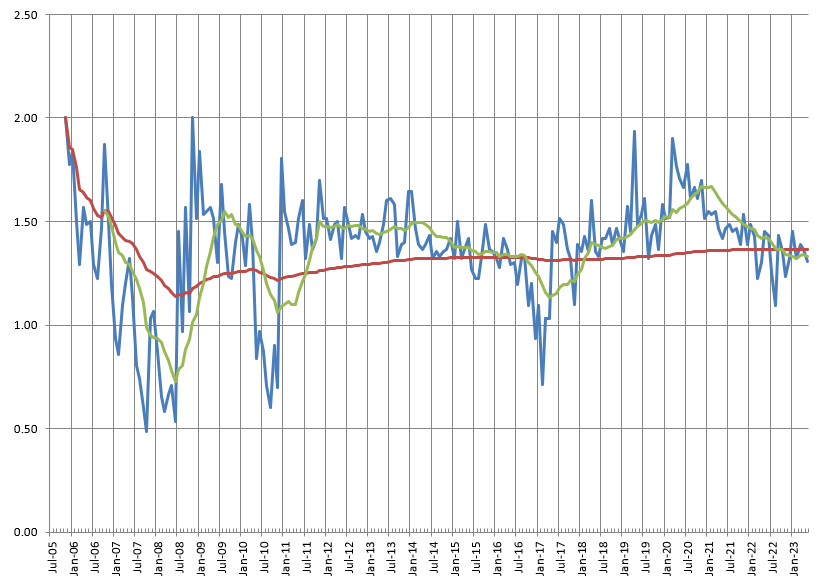
Right now, I'm predicting the 10,000th post on 5 August 2025. Keep reading and find out.